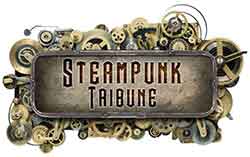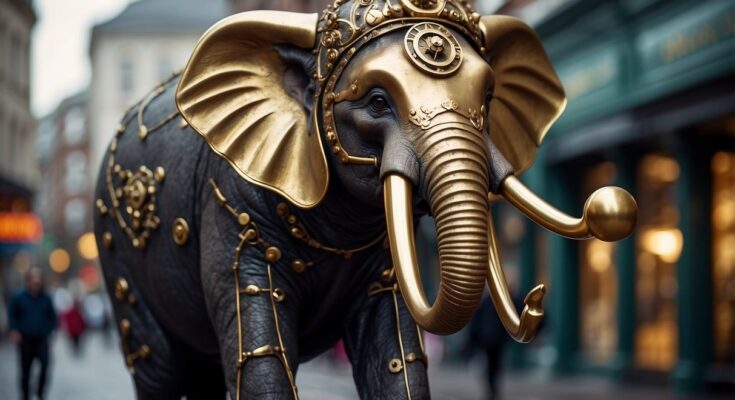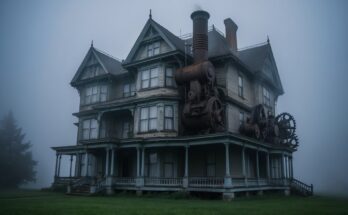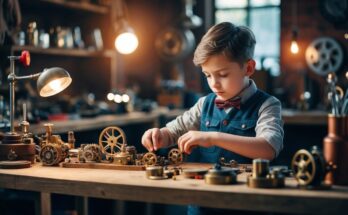The world of steampunk blends Victorian aesthetics with advanced steam-powered technology, creating a unique lens through which to view the natural world. Steampunk animals serve as fascinating representations of this movement, often embodying a mix of science fiction and fantasy elements that capture the imagination. They are frequently portrayed with mechanical enhancements, combining biological traits with clockwork gears and intricate designs.

Artists and writers in this genre often explore themes of nature versus machine, transforming everyday creatures into extraordinary beings. These representations not only showcase creativity but also provoke thought about the relationship between humanity, technology, and the environment. By examining steampunk animals, one can gain insight into this vibrant and imaginative subculture.
The allure of steampunk animals lies in their ability to transport audiences to alternate realities, where the constraints of modern science and nature are redefined. Observing these unique creations allows enthusiasts to appreciate the artistry involved in blending the familiar with the fantastical, leading to endless possibilities in storytelling and visual art.
Origins of Steampunk

Steampunk is a genre that draws heavily from historical elements, particularly the Victorian era, and incorporates technology inspired by steam power. Its emergence can be traced through various movements in literature and visual media.
Historical Influences
The roots of steampunk lie in the industrial revolution, where steam power revolutionized machinery and transportation. This era is characterized by the rise of gears, cogs, and mechanical innovations. Authors like Jules Verne and H.G. Wells crafted narratives that merged fantastical elements with the latest scientific advancements. Their works laid the groundwork for steampunk by weaving technology into imaginative storytelling, showcasing machines like airships and submarines.
The Victorian era, with its distinct fashion and culture, profoundly influenced steampunk aesthetics. Society’s fascination with progress and invention featured prominently in art, literature, and design. Illustrations from this period often depicted elaborate machines, emphasizing a blend of beauty and functionality. This convergence of history and imagination created an ideal backdrop for steampunk’s development.
Rise in Popular Culture
Steampunk began gaining traction in popular culture during the late 20th century. The genre expanded from literature into other forms of media, including movies, art, and fashion. Films such as The City of Lost Children and Wild Wild West introduced mainstream audiences to steampunk’s unique visual style.
Conventions and fan gatherings dedicated to steampunk have proliferated, showcasing the movement’s growth. These events celebrate creative expressions through costumes, art, and technology, reflecting the genre’s innovation. Books and graphic novels have also played a pivotal role, with titles like The Anubis Gates and Leviathan integrating steampunk themes into engaging narratives.
Through its historical influences and modern adaptations, steampunk remains a dynamic cultural movement.
Steampunk Animals in Art

Steampunk animals in art combine imaginative mechanical designs with biological forms. This genre showcases unique creations that reflect both craftsmanship and a love for nature, often utilizing various materials to bring these fantastical creatures to life.
Sculpture Artists
Several artists stand out in the realm of steampunk animal sculptures. Igor Verniy is known for his intricate mechanical designs, often featuring birds and insects made from scrap metal and found objects. His work exemplifies precision and creativity.
Hasan Novrozi utilizes recycled materials to form lifelike representations of animals. His sculptures reflect biological accuracy while incorporating mechanical details.
Andrew Chase creates unique pieces that often include watch parts, emphasizing movement and function in his sculptures. Meanwhile, Mike Libby specializes in creating steampunk insects, infusing his work with a playful yet detailed aesthetic.
Artistic Techniques
The techniques employed in creating steampunk animals often involve the use of recycled materials. Artists commonly work with scrap metal, gears, and watch parts to construct their sculptures.
Using welding and metalworking skills, they assemble these components into intricate designs. Precision is essential, as artists must balance mechanical elements with organic forms.
Some artists use found objects to introduce textures and colors, contributing to the overall aesthetics. Painting and patination techniques may enhance the vintage appearance of the sculptures, providing a richer visual experience.
Artistic Representation
Steampunk animals frequently embody a blend of fantasy and realism. Artists aim to achieve biological accuracy while imbuing their works with imaginative mechanical features.
Mechanical animals, such as steampunk birds or insects, incorporate gears and alarms to create a semblance of life. This fusion captivates viewers, inviting them to ponder the relationship between nature and technology.
The whimsical designs often provoke discussions about the impact of industrialization on the natural world. These pieces serve not only as artistic expressions but also as commentaries on the evolving connection between humanity and nature.
Science and Engineering
The integration of science and engineering in steampunk animals creates a fascinating blend of mechanical artistry and biological inspiration. Innovations in mechanical design, the crossover with biology, and emerging technologies drive this unique field.
Mechanical Design
Mechanical design in steampunk animals emphasizes intricate features that mimic real life. Artisans use gears, pulleys, and steam-powered mechanisms to create movements that resemble those of actual animals. The aesthetics often draw from Victorian influences, incorporating brass, copper, and wood.
Designers focus on animal structures, adapting anatomical principles for mechanical function. Articulated joints allow for lifelike movement, while sensors, powered by small steam engines or electrical components, respond to environmental stimuli. This mechanical artistry challenges conventional engineering norms, demanding creativity and precision.
Intersection with Biology
The intersection with biology is key in steampunk animal creations. Artists study animal anatomy to ensure that mechanical counterparts are realistic yet imaginative.
Research in natural sciences informs these designs, allowing creators to replicate biological processes. For instance, components can simulate muscle movement through levers and springs, making the steampunk creations not only visually appealing but functional. This blend of mechanical engineering and biological insight fosters innovative constructs that push the boundaries of traditional craftsmanship.
Emerging Technologies
Emerging technologies play a crucial role in advancing steampunk animals. Robotics and API integrations allow developers to introduce complex functionalities that were once inconceivable in the realm of mechanical design.
Modern 3D printing opens new avenues for creating intricate parts, enhancing detail and customization. Additionally, advancements in artificial intelligence enable these creatures to exhibit behaviors that mimic their natural counterparts. As technology evolves, the possibilities within steampunk engineering expand, merging historical aesthetics with futuristic innovation.
Commercial and Social Aspects
Steampunk animals have carved out a unique niche in both the commercial art market and social spheres. Their appeal reaches various audiences, connecting creators with fans through products and community engagement.
Market for Steampunk Art
The market for steampunk animals includes a diverse array of art forms, from intricate models to digital fan art. Platforms such as Etsy feature numerous collections, where artists sell their handmade pieces, often showcasing a blend of Victorian aesthetics and imaginative designs.
Consumers are drawn to these creations for their distinctive character and craftsmanship. Many models incorporate elements such as gears, metal, and leather, reflecting the steampunk genre’s mechanical influence.
This art style attracts both casual collectors and serious aficionados, making small projects a viable business for many artists. Events, conventions, and online marketplaces serve as hubs for buying and selling, facilitating the growth of this niche market.
Community Engagement
Community engagement plays a significant role in popularizing steampunk animals. Online forums, Facebook groups, and local clubs foster discussions surrounding lore, design, and artistic techniques. Members share ideas, create collaborative works, and inspire one another.
Many artists host workshops or participate in events, bringing enthusiasts together to learn and create. They also showcase their work at conventions, allowing a face-to-face connection that enhances community bonds.
This engagement not only strengthens the fan base but also encourages newcomers to explore the genre. Networking within these communities can lead to collaborations, expanding the reach and impact of steampunk art.
Influence on Corporate Branding
The steampunk aesthetic has uniquely influenced corporate branding strategies. Companies often utilize steampunk animals in marketing campaigns to evoke nostalgia and fascination in their products. Their designs resonate well with audiences seeking individuality and creativity.
Brands that embrace this style often craft product lines that incorporate steampunk elements, appealing to fans. This approach can differentiate them in competitive marketplaces. Using steampunk imagery can also enhance storytelling aspects of a brand, connecting consumers with deeper narratives.
Incorporating steampunk themes into product design can result in memorable marketing strategies, potentially increasing sales and consumer loyalty. By tapping into this rich cultural movement, corporations can effectively engage with a passionate audience.
Exhibitions and Showcases
Exhibitions and showcases play a significant role in bringing steampunk animals to a wider audience. They provide platforms for artists to display their unique interpretations of animal sculptures, blending imagination with craftsmanship. Different formats, including public displays and virtual galleries, offer diverse experiences for enthusiasts.
Public Displays
Public exhibitions of steampunk animals often take place in galleries, museums, and science fiction conventions. These events showcase large-scale sculptures and intricate installations that highlight the creativity of various artists.
Visitors can interact directly with the art, taking in the details up close. Sometimes accompanied by workshops, these displays allow for a deeper appreciation of the techniques used in creating steampunk artwork.
Notable exhibitions frequently include artist talks, where creators share their inspirations and artistic processes. Additionally, curated collections may feature standout works, giving insights into how steampunk aesthetics blend with animal forms.
Virtual Galleries
Virtual galleries are becoming increasingly popular in the art world, including the realm of steampunk animals. These digital platforms allow artists to showcase their work to a global audience without geographical limitations. Virtual exhibitions can feature high-definition photos of intricate sculptures, giving viewers an immersive experience.
Interactive elements, such as 3D models and video walkthroughs, enhance engagement. Artists can present their portfolios alongside detailed descriptions or blogs discussing their creative journeys.
Online showcases also offer opportunities for collaboration among artists, as they can connect and share ideas in digital spaces. Through social media and dedicated websites, steampunk animal art can reach enthusiasts and collectors worldwide.
Steampunk Animals in Literature and Media
The concept of steampunk animals blends Victorian aesthetics with whimsical elements of fantasy and science fiction. Through literature and visual media, these creatures inhabit unique worlds where technology intersects with imagination.
Books and Stories
Steampunk animals frequently appear in literary works, creating rich narratives that captivate readers. Jules Verne’s influence is notable, with his tales featuring mechanical beasts that reflect the era’s fascination with invention. In many stories, animals are depicted with brass gears, clockwork mechanisms, and steam-powered enhancements.
For example, Philip Reeve’s Mortal Engines series introduces a variety of mechanized creatures that inhabit a dystopian future. Additionally, The League of Extraordinary Gentlemen by Alan Moore includes anthropomorphized animals that retain their original characteristics while being infused with steampunk technology. Such portrayals enrich storytelling by combining familiar animal traits with imaginative machinery.
Visual Media Representation
In visual media, steampunk animals are brought to life through films, television, and web series. Illustrators skillfully design these beings, showcasing them as companions or protagonists in their respective narratives. The series The Golden Compass features armored polar bears, while the film Wild Wild West showcases mechanical insects.
Moreover, the animated film Aardman’s Arthur Christmas includes inventive animal designs that embody steampunk aesthetics. These representations highlight how animals can be reinterpreted through a steampunk lens, enhancing the visual experience and engaging audiences with novel character designs and backstories. This melding of technology and zoology showcases the versatility of steampunk as a genre.
Educational Impact
The concept of steampunk animals presents numerous educational opportunities. By integrating elements of science, engineering, and culture, it fosters creativity and engagement among learners. These components contribute to a multifaceted approach to education, enhancing critical thinking and problem-solving skills.
Teaching Science and Engineering
Steampunk animals can serve as compelling tools for teaching STEM subjects. Through designing mechanical creatures, students gain a practical understanding of engineering principles.
Key Areas Include:
- Mechanics: Students learn about gears, levers, and basic physics by building moving parts.
- Biomimicry: Projects can explore how animal adaptations inspire innovative designs.
- Hands-on Learning: Creating models encourages collaboration and experimentation, essential in scientific inquiry.
Such activities not only solidify theoretical knowledge but also promote critical thinking and creativity in problem-solving.
Cultural Significance
The fusion of art and technology in steampunk animals provides insight into historical context and cultural evolution. This genre allows students to explore the Victorian era’s influence on modern design and architecture.
Learning Aspects Include:
- Art and Design: Students analyze the aesthetics of steampunk and its relation to industrial history.
- Cultural Studies: Discussions can focus on how steampunk reimagines societal norms and technological advancements.
- Project-Based Learning: Schools can implement projects that require researching historical figures or events linked to the steampunk movement.
This integration underscores the relevance of culture in modern education, offering a unique perspective on innovation and creativity.
Creating Your Own Steampunk Animals
Crafting steampunk animals combines creativity with a wide array of materials and techniques. Artists can express their individuality while exploring the unique aesthetic of the steampunk genre through various DIY projects.
DIY Steampunk Art
Creating steampunk animals starts with imagination and a clear concept. An artist should begin by sketching ideas that blend elements of both the natural world and the mechanical. These sketches guide the creation process, helping to visualize how organic shapes can merge with gears and tubing.
Using recycled materials is a hallmark of steampunk art. Items such as old electronics, metal parts, and household items can serve as perfect components for sculptures.
Adding details like copper wires, gears, and brass accents can enhance the overall design. Popular projects include crafting mechanical insects or robotic pets. Tutorials can provide step-by-step guidance, ensuring even beginners can successfully bring their designs to life.
Materials and Tools
Artists need a variety of materials and tools to create their steampunk animals. Essential supplies include:
- Base materials: Wood, metal, and plastic.
- Accents: Gears, cogs, and clock parts sourced from old appliances.
- Adhesives: Strong glues like epoxy or hot glue for secure assembly.
Common tools include:
- Hot glue gun: For quick bonding.
- Craft knife: For cutting intricate shapes.
- Pliers: For manipulating metal components.
In addition, building techniques should be employed for stability and balance. Artists may opt for a layering technique to add depth or use a frame structure for more significant sculptures. Each choice reflects personal style and enhances the final creation.




